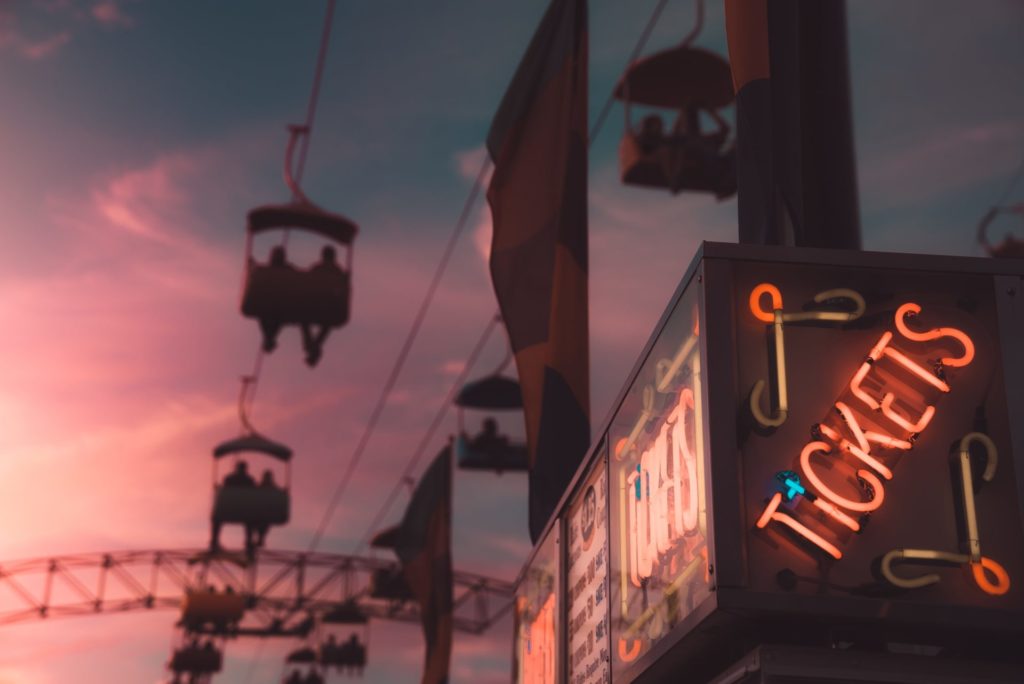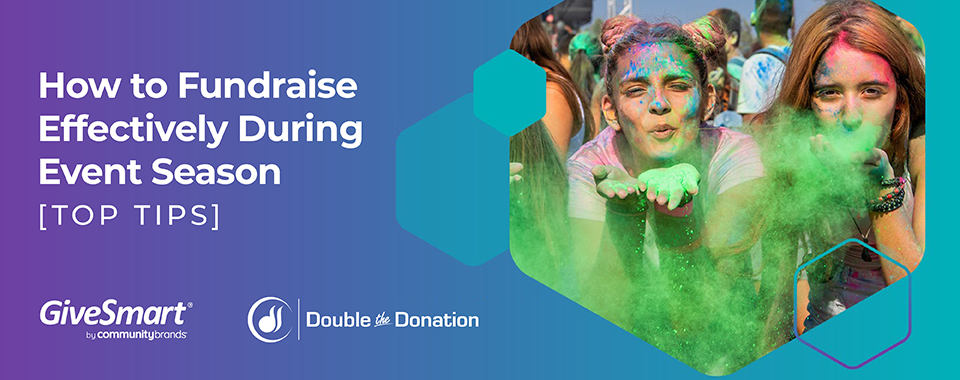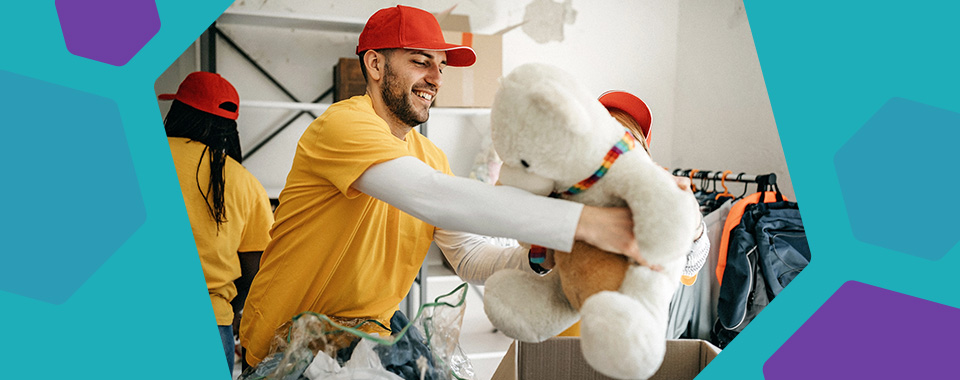Sep 12, 2019
12-month signature event masterplan
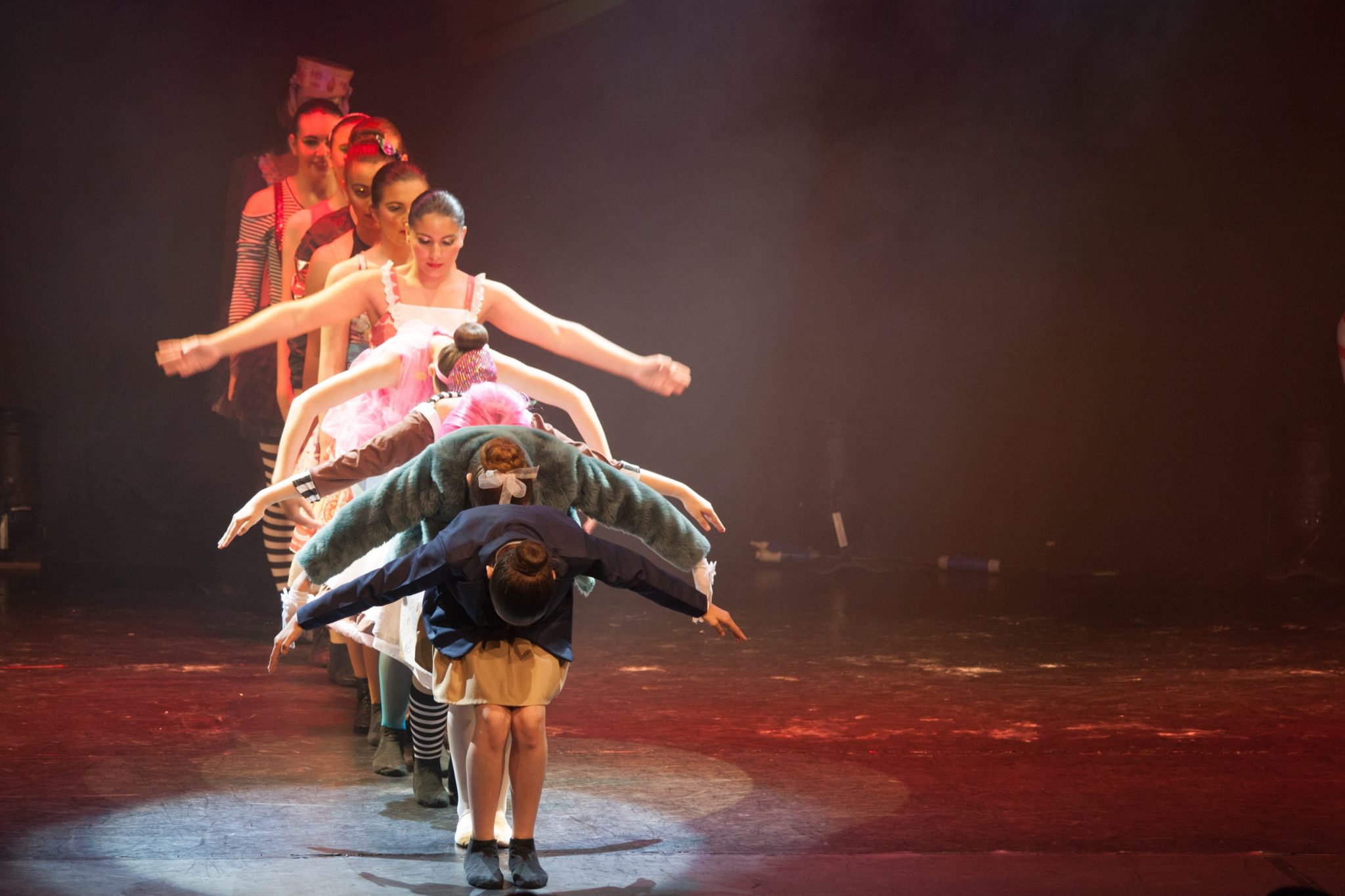
It’s time for a new approach to event planning.
Tips, timelines, and checklists to help you plan better events, reduce stress, and raise more money… all year round.
A joined-up approach, that turns one-off donors into regular supporters. That leaves less money on the table. That lets you actually enjoy what you do. This year-round timeline will get you started.
Think about your big fundraising event. How do you feel? If it’s anything other than calm, confident, and in control, this plan is for you.
Don’t get us wrong. There’s a lot riding on your event, and a lot of things need to come together to make it work. A few nerves are inevitable—that’s what makes the job so exciting. But if you spend all your time fighting fires, you’ll never do new things that will really engage your donors. Chances are, there are opportunities right under your nose. Good preparation is the key to a successful signature event. And although no event is ever completely stress-free, getting your early planning right can really help.
12 MONTHS OUT: BUILDING FOUNDATIONS
A successful event starts at least a year in advance—when you decide your goals, budget, concept, assign committee responsibilities, and start to build relationships with key vendors and sponsors.
Things to do 12 months out:
- Agree your budget
- Set your goals
- Decide on a theme
- Choose a venue
- Start to approach vendors and sponsors
Set your budget.
How much should you spend, and how much will you raise?
Your first step is to plan out what you can afford to spend and how much you hope to make with this signature event. Once your budget is set, it is wise not to deviate from your set expenditures (unless emergency situations arise). If you do deviate, you should also adjust your goal accordingly.
“As an initial goal, aim to raise 110% of what the event costs to run.”
– Erin Shy, Executive Vice President of Nonprofit Solutions & Event Technology, Momentive Software
Your event budget should include:
- Staffing costs
- Venue
- Catering
- Entertainment and speaker fees
- Marketing
- Event management software
- Operational costs
Goal setting tips & tricks.
Are you overjoyed at what you’ve raised? Do you feel like there’s no way you could raise more? If your answer is yes to both, congratulations! Fundraising Hall of Fame for you!
If you *feel* like there’s definitely room to raise more, like feel it in your bones, we’re here to tell you, you’re right. No matter how well you did last year, you have material room to improve. And that takes planning. Starting the day after your annual event. Ok maybe two days after your annual event.
As soon as possible after your annual event, ask yourself these questions:
1. Did every person who attended and expected to donate do so? Did we capture everyone’s contact information?
2. Are there folks who intended to attend and donate, but couldn’t attend – did we capture their donation intent?
3. Did we lose revenue on the silent auction due to:
- Distractions from the live appeal
- Silent auction items weren’t clear enough on the app
- Donors with intentions couldn’t access
Prioritize the areas where you hypothesize you can capture and collect more. Dream big. What’s your moonshot? Bonus points for priorities that require no additional investment.
Choosing a theme or concept.
A theme is fun for your audience and makes the planner’s life easier too.
A good theme or concept can help you to gain publicity and sell tickets. But it also makes planning easier. Your theme gives the committee and planners a hook to guide decorations, invitations, entertainment, and the many details throughout the event. In a world of possibilities, it helps to make decision-making simple and to align people around a shared vision.
When do you choose your event concept or theme?
- Right at the start—it’s the first thing we decide
- Between a year and six months in advance
- Less than six months out
- We don’t change the concept; it’s the same every year
Your event venue: 5 things to consider.
This list could go on for days. Here’s what we consistently hear are the top 5:
1. Allow a little more room than you think you need.
Choose a venue that has a little extra space, in case you exceed your goals. If you expect 400 people, make sure your venue can handle at least 425. You don’t want to turn potential donors away.
2. Think about the practical elements your event needs.
Before your final decision test of the audio-visual components. Test cell reception and wifi. Don’t forget about parking or safe ride options.
3. Consider the food and beverage options.
A venue with its own catering service is convenient, but make sure the prices aren’t gouged and check that the food fits your theme and crowd. Chicken fingers and macaroni might not be the best fit for a black-tie gala but is perfect for an “un-gala”.
4. How important is a central location?
It’s important your event is easy to get to—and a central location is a better bet in some cities than others. Consider a location’s accessibility and the timing of when people are coming to the event. Traffic is very different on a Friday night compared to a Sunday.
5. How does the space fit your event flow?
Walk through a guest’s experience throughout the night. Where will the silent auction go? Will everyone be able to see the stage? These might sound like small details, but they’re important to your guests—so they’re key elements when you pick your venue.
Contact sponsors early.
Event sponsors often set their budgets early. Contact them as soon as the details of your event are confirmed.
This also applies to current sponsors that you’d like to bring back. Don’t assume they’ll include you in their budget for next year—keep the relationship open and involve them in your early-stage plans.
Top tip: prepare packages in advance. Have your sponsor packages ready before you reach out. Try to have a flexible offering, with an option to stay involved all year round, as well as sponsoring the one event. By working with sponsors early, you open up the opportunity to offer a more comprehensive and innovative package that can further engrain a sponsor into your giving environment. Create packaging and opportunities for current and new sponsors to support your signature event along with year-round efforts.
6 MONTHS OUT: BUILD EXCITEMENT
With the big decisions made, it’s time to get the word out—and to arrange key partners who will help you deliver your event.
A quick guide to marketing your event.
Techniques you might want to consider.
The best marketing approaches depend on the age of the people who’ll attend your event. Traditional techniques like mail and telephone calls work best for older generations. If your audience is younger than, say, 50, you might also want to think about some of the following:
For ages 18-49: Facebook
Join relevant groups, to share a variety of content types: links, images, and videos. You’ll also need to set aside some funds for paid advertisements if you want your event page to be seen.
For ages 18-mid-20s: Twitter
Use tools like Hashtagify.me and Keyhole to find the best hashtags to get the attention of potential attendees. But don’t overdo it: engagement drops if you use more than two hashtags, or tweet more than three times a day.
For professional contacts: LinkedIn
LinkedIn is a useful way to attract the attention of professionals and sponsors. Join groups relevant to your cause—but be sure to engage with other posts too, otherwise, you will risk being marked as a link spammer.
Content marketing and SEO
Lots of nonprofits are having success with a content marketing strategy—sharing powerful, shareable content to capture the imagination. It’s also important that your content can be found on search engines; our event marketing guide can help you with that.
There are three steps to building a successful email marketing campaign:
- Connect
Your email campaign should tell a story. Introduce the reader to the problem you are trying to solve and explain how your fundraiser event is the solution to the issue. - Educate
Your email must include the where, when, why, and how of your event. Where will the event take place? When will it take place? Why are you hosting this event? And how will attending your event solve your problem? - Offer
In your email campaign, make early registration offers to potential guests, such as lower attendance fees or entry into a raffle of some kind. Give your email readers something special they wouldn’t get anywhere else.
How data can help you set your ticket price.
Your ticket pricing sets the tone for who’ll attend—and it’s a balancing act.
If your price is too low, you might not attract top-dollar donors…
…but set it too high and you could exclude attendees who’d donate more during an auction or appeal.
You can find your sweet spot by looking at data from previous events.
If people who bought more expensive tickets also donated strongly, the higher ticket price works for you. But if most of your auction and appeal revenue came from attendees with cheaper tickets, lowering your price could increase your income overall.
Know your donors.
There are various ways to find out more from your donors, but here are a couple of ways to collect extra data.
- Survey donors about your event and pricing.
- Ask key donors in a group setting like at a cocktail hour.
- Utilize your board to collect qualitative feedback from their guests.
Year-round opportunity:
During ticket sales, you should plan to have a donation ask to capture early donations and allow donors that want to give on top of their ticket purchase or registration. This is a great way to set someone up on monthly giving, if that is something you offer.
How and why to choose your event technology.
Utilizing an event fundraising software to run your event will save your team stress…and quite a few trees.
The right software will make it easier to handle all your administration, run a smooth event on the night, and build year-round relationships with your donors. In short, they help you worry less, and raise more. That’s why we’ve written an unbiased guide to what you should be looking for in a supplier.
And of course, we’d love for you to choose GiveSmart. But there are a lot of silent auction software companies out there today, and the most important thing is that you find the one that’s the best fit for your organization.
It’s important because it becomes your hub for donor details, financial information, auction inventory, and more, so it really needs to work for you.
“Having the silent auction, live auction and general appeal for donations through GiveSmart’s mobile platform was great! It was seamless.”
– David Sean Brennan, Los Angeles Dodgers Foundation
Year-round opportunity:
When looking at any fundraising software, identify components that can be used year-round, for instance ticketing, text-to-donate, online auctions, and other fundraising components that wouldn’t cost extra but can enhance a smaller micro-event.
3 MONTHS OUT: BUILD YOUR AUDIENCE
Now is the perfect moment to open registration and ticketing. It’s close enough to be exciting, but plenty of time for people to be free.
“Start selling your tickets around 3 months before your signature event to make sure you are on donors’ radar in plenty of time and you have time to promote all the various fundraising components.”
– Steve Greanias, VP Account Management, GiveSmart by Momentive Software
3 months out:
-
Open ticketing and registration
-
Contact local media
-
Send formal invitations
-
Arrange appeal presenter or video
-
Confirm details with sponsors
-
Plan your follow-up strategy
Information to have on your ticketing and registration page:
• Name of event and organization
• Date, time, venue location
• Mission statement
• Ticket types: cost and what’s included (dinner, scrolling sponsor, etc. whatever recognition is included in a sponsorship package)
Local Media Coverage:
Starting from scratch?
- Make a list of local newspapers, tv, radio, facebook communities
- Go to their websites and search “contact us”
- Depending on the publication, they might have contact information broken down by section, individual reporters, or both
Novice or Super-Experienced?
Remember, these folks are inundated with requests, so make your ask shine:
- Contact the department you feel is the best fit or a particular journalist that you know covers community events
- Radio and television often run public service announcements. Contact your local outlets, request a spot, and include information about your event in your “ad”
- Write a compelling pitch that includes your organization’s mission, why they should attend your event, all details. A press release should accompany this pitch.
- Send off, and follow up if you don’t hear back!
Year-round opportunity:
Set your fundraising up for success by preparing stories and impact reports to encourage frequent giving as donors are buying tickets and registering. By utilizing technology, you are able to engage guests in advance, while also giving supporters who cannot attend a chance to register and bid or donate.
Plan your follow-up strategy.
It might seem far off, but take the time to think about how you’ll follow up with your donors. Our survey shows the message you send—and how you send it—is crucial.
The age of your audience makes a big difference to what they want… but those preferences aren’t what you might expect.
Planning your live presentations.
Check off the below items related to your live presentation:
1. Confirm with the venue on Audio/Visual capabilities and with any vendors that are presenting on their needs.
2. Identify whether the mission story will be shared by video, live speaker, or a performance.
3. If you are using a live auctioneer, confirm event details with them and spend some time discussing your mission, story, and goal.
4. Video is the most popular way to share your story at a live event. Utilize this in some way. There are several software companies out there.
[Webinar] Paddles Up: Nailing the Live Appeal
1 MONTH OUT: BUILD YOUR CONFIDENCE
The last month before your event is the time to lock down all the crucial details, so you can focus on delivering the best results.
1 month out:
-
Create run-of-show plan
-
Table and seating plan
-
Venue plan
-
Fundraising plan
-
Back-up Plan
-
Engage with your guests
When planning for your check-in, checkout, and various other tables, take into account the flow of the guests at your event and consider where there might be poor lighting or herded cattle which would not be optimal for your guest’s experience.
Venue setup:
Think about the flow of guests when they arrive at your event, from parking to finding their seat at a table. Consider table placement throughout the space. It’s important to optimize your venue to prevent a bottleneck at check-in and chaos at checkout. Thinking through your event and the physical setup will set you up for smooth transitions and better guest experience.
Preventing lines:
Donors, like anyone else, do not like to wait in line for anything. No shocker, right? To prevent this use some of these guidelines:
1. For every 75 guests have 1 check-in person.
2. Prepare the silent auction packages for pick up while another activity is going on in another room.
3. Engage donors as they enter and leave so they know about all traffic options and know where to go.
Tips for a Solid Run of Show:
ROS (run of show) is a schedule that will help you delegate team members and manage tasks before, during, and after your event. The ROS is also a great reference to share with vendors, volunteers, and staff to answers any questions related to event-day duties and timing.
Your ROS should be a timeline, starting with the very first thing that happens on event day and ending with the time that everyone must be out of the venue. Everything in between should be accompanied by a time, location, and a specific contact person. When you outline tasks for staff and volunteers be sure to list specific people.
For example:
- 9 a.m. lighting and sound crew arrives – back entrance – Steve 223-444-1234
- 5 p.m. volunteers arrive – check-in with Lucy in foyer – John (phone), Kate (phone)
- 6 p.m. check-in begins – foyer entrance – Kate (phone) + Lauren (phone)
Fundraising Plan:
To maximize your fundraising it’s a good idea to plan. Will you open your auction before the event? What time will you close the auction? Will you extend the auction if you haven’t reached your goal? How frequently will you communicate with guests via text message? When will you send out a text (or two) asking for donations?
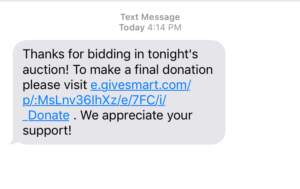
Back-up Plan:
No one likes to assume the worst, but when planning a big event you must have back-up plans for what you might consider to be a “worst-case scenario.” For example, your honoree is no longer able to make it, your MC/host can no longer attend, entertainment falls through, inclement weather, etc. Talk through these situations with your team and prepare a plan. In the event a worst-case scenario happens, you’ll be happy that you took an extra ten minutes to think through what you’ll do.
“If you’re counting on a VIP guest, remember to send them a ‘thank-you’ before the event. It’s a polite thing to do, and it also reminds them it’s important to show up!”
– Brandon Stec, Director of Marketing, GiveSmart by Momentive Software
Keep guests engaged.
Leading up to your event send guests reminders, alternating between text and email. Don’t bombard them but do send friendly reminders to get them excited for the event. If you still have tickets available encourage guests to invite their friends. You could also use this as an opportunity to provide an incentive if they bring additional guests (i.e. “if your friend purchases a ticket let us know and we’ll put ten raffle tickets in the bin with your name on them!”).
Additionally, if you’ve invited members of the local media, send them reminders too. Be sure to include entrance instructions and who they should speak with when they arrive at the venue.
EVENT WEEK: TIME TO DELIVER
If you’re not feeling a little nervous energy by the final week, you’re not doing it right. It’s time to trust your planning, dial down the stress, and use these resources to help you maximize your fundraising on the night.
The last few days: getting the details right.
Your planning so far has got you ready for success. Now it’s time to look at the details to get the most from your event.
Create great item display sheets.
Your auction item display sheets should include everything someone needs to bid. Include all the details of the item – with pictures, if they’re helpful – and information on how to bid.
Ace your seating plan.
Having a strategic plan in place for where and how you seat people at the event, will allow you to put the bigger donors towards the front in preparation for all their bids and paddle raises.
Open the auction early, online.
If you’re having a silent auction it doesn’t hurt to start bidding early! Opening your silent auction gets guests excited for your event, familiarizes them with the mobile bidding platform, and encourages them to start spending! This allows you to start event night with money already raised. You don’t want to open the auction any more than a week in advance of your event. You do want to encourage guests to share the auction with others who might be interested in supporting the organization but cannot attend.
Event day: make sure everyone knows the plan.
Event day is time to make sure everybody on the team understands how the show will work, and their part in making it happen. We love it when a plan comes together.
It is essential that you make sure everyone knows where they’re assigned, and when and how to move from one role to another during the night. Having the run-of-show for everyone will be a big help as the event goes along.
Managing Volunteers
Set up your volunteers for success with specific instructions, tasks, and scheduling. Volunteers are best when they know what they are responsible to be doing and can contribute to the success of the event without learning a new skill.
Arrival and parking instructions
Consider working with a rideshare or valet service to make for easier entrance and departure to your event.
Quick reminders:
- Set up break room for vendors and volunteers
- Always check your A/V and lighting
- Connecting auctioneer/MC to other staff for necessary details
THE MOMENT OF TRUTH.
You’ve planned brilliantly, but anything can still happen. Give yourself the flexibility to make decisions on the fly and maximize every fundraising opportunity as it arises.
Silent auction tips: On event day you’ll need to be proactive and think on your feet. If you’re approaching the end time of your auction, but see that guests are furiously bidding, extend it! It will be your call how long, but see if you can keep up the momentum, and make a bit more money. The same can be said for an auction that maybe hasn’t quite met its goal. Extend the auction and have the host go on stage and run through great items that still need bids, while simultaneously sending that text message (with a link to those items) to guests.
Raffle tips: If you have a raffle happening and would like to see more action, again, have the host make an announcement and simultaneously send a text message with a link to the raffle tickets, or instructions to where the raffle station is located.

Anytime someone is giving instructions on stage regarding fundraising, it’s a great idea to utilize the text communication tool. Interact with guests in real-time, making it as easy as possible for them to give.
Live auction tip: If you’re having a live auction it’s a good idea to ask donors ahead of time if you can duplicate the item they’ve donated. This is a great trick to have on hand so that if a bidding war levels out on a great item, you can then ask both donors if they’d like to give $2,000 for those courtside seats. This then brings in $4,000 instead of $2,000. This isn’t always possible, but it’s good backup intel to have!
We built a Signature Event Planning Checklist so you can jump in and start working.
WHAT TO DO AFTER YOUR EVENT
The event may be over, but you’re not done quite yet! It’s time to cement relationships, take stock…and start making sure next year is even better.
The essential 6: after your signature event.
It’s almost time to reboot your event planning cycle. But first, there are six things you must do.
1. Thank your donors, sponsors, attendees, volunteers, vendors…etc. EVERYONE.
2. Settle up vendors and expenses. Reconcile any pending donations and pledges.
3. Review the data and compare to goals.
4. Compile an impact story and report.
5. Take a mental and physical break.
6. Build your plan to capture the goodwill from the event to drive more year-round donations.
This donor experience research study shows how donors want to give and what means most to them in a donor-organization relationship.
“Our customers are telling us that they’ve been able to drive 3-5 more successful micro-events through the year. Out-performing their year-round giving and expanding their donor base. Our donor survey even told us most donors give approximately 4 times per year.”
– Brandy Keller, Director of Product Marketing and Management, GiveSmart by Momentive Software
Use this year’s data to improve next year’s event.
Your event data isn’t just about this year’s performance. You can use it to guide you for next year—everything from your budgets and ticketing to identifying the most important items from your auction.
Event data can help you predict the future:
- Which auction items will give you the best return
- Which dates and locations will work best
- How different donor types will respond
- When to open and close your auction
- What size venue do you need
For example: Say you can get tickets for Hamilton… Will that generate ROI?
Hamilton tickets are a hot item—they appear in thousands of GiveSmart auctions. And you might think they’re a sure bet.
Data from past events can tell you whether the location of the show makes a difference (in this case, it does) and whether the date of the performance matters (not so much).
“It’s a lot of work for our volunteers to procure a bunch of different items—so the data is great because it gives us a bird’s eye view of what went well, and what to look for next year.”
– Tia Senour, Development Manager, Our Lady of Lourdes Classical Catholic School and Parish
TIPS FOR SUCCESSFUL YEAR-ROUND EVENTS
When you add other events beyond your main gala, it opens all kinds of possibilities. New donors. Varied donation sizes. Greater awareness. Opportunities to give, all year round.
Planning micro-events.
Obviously, the signature event might be the BIG night, but there are plenty of other micro-events you may be running throughout the year. Here are some tips to continue using this year-round masterplan for those additional events.
Some types of micro-events:
-
Golf Tournaments
-
Bowling
-
Luncheons
-
Performances/Art Shows
-
Sponsor hosted event
-
Bingo night
-
Casino night
-
“Un-Gala”
-
Walk/Run
-
Trivia night
-
Happy hour/cocktail event
-
Donation drive
-
Sports competition or tournament
-
Watch parties
-
Board meetings
-
Farm-to-table dinner
-
Wine tasting
[Webinar] Your Donors: Keep ‘Em Close.
How to engage your donors all year round.
Related


